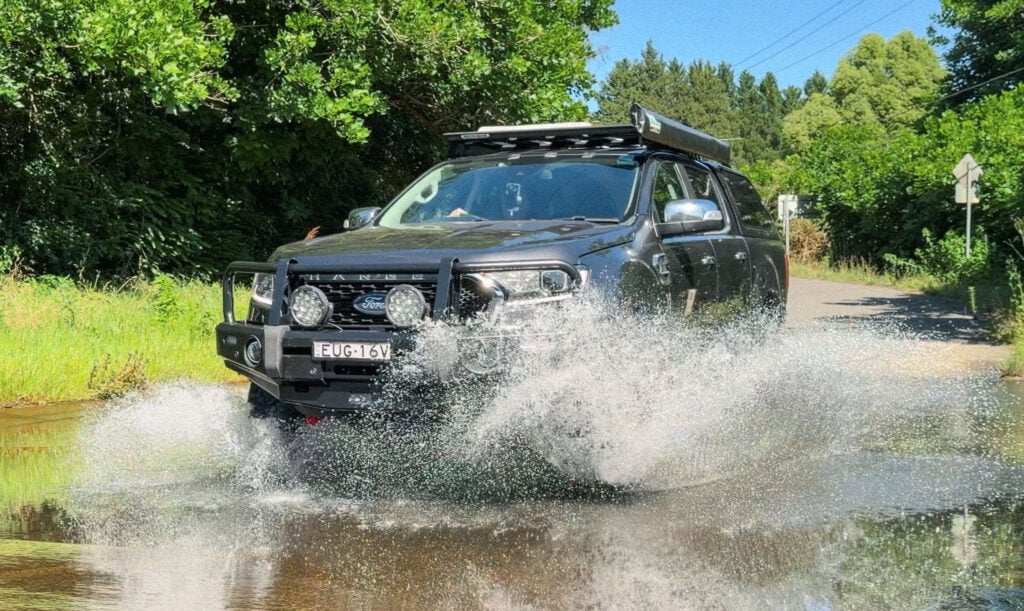Things we like
- Huge performance
- Impressive practicality
- Set to come here!
Not so much
- Ergonomic niggles
- Low-feel steering
- Bargain US pricing won't translate
Wheels first drive review
The Wheels Verdict: The new eighth-generation Corvette’s mid-mounted engine marks the most radical change since the first one appeared in 1953. Even the basic version blurs the lines between sportscar and supercar – the prospect of a Holden-badged version is an exciting one.
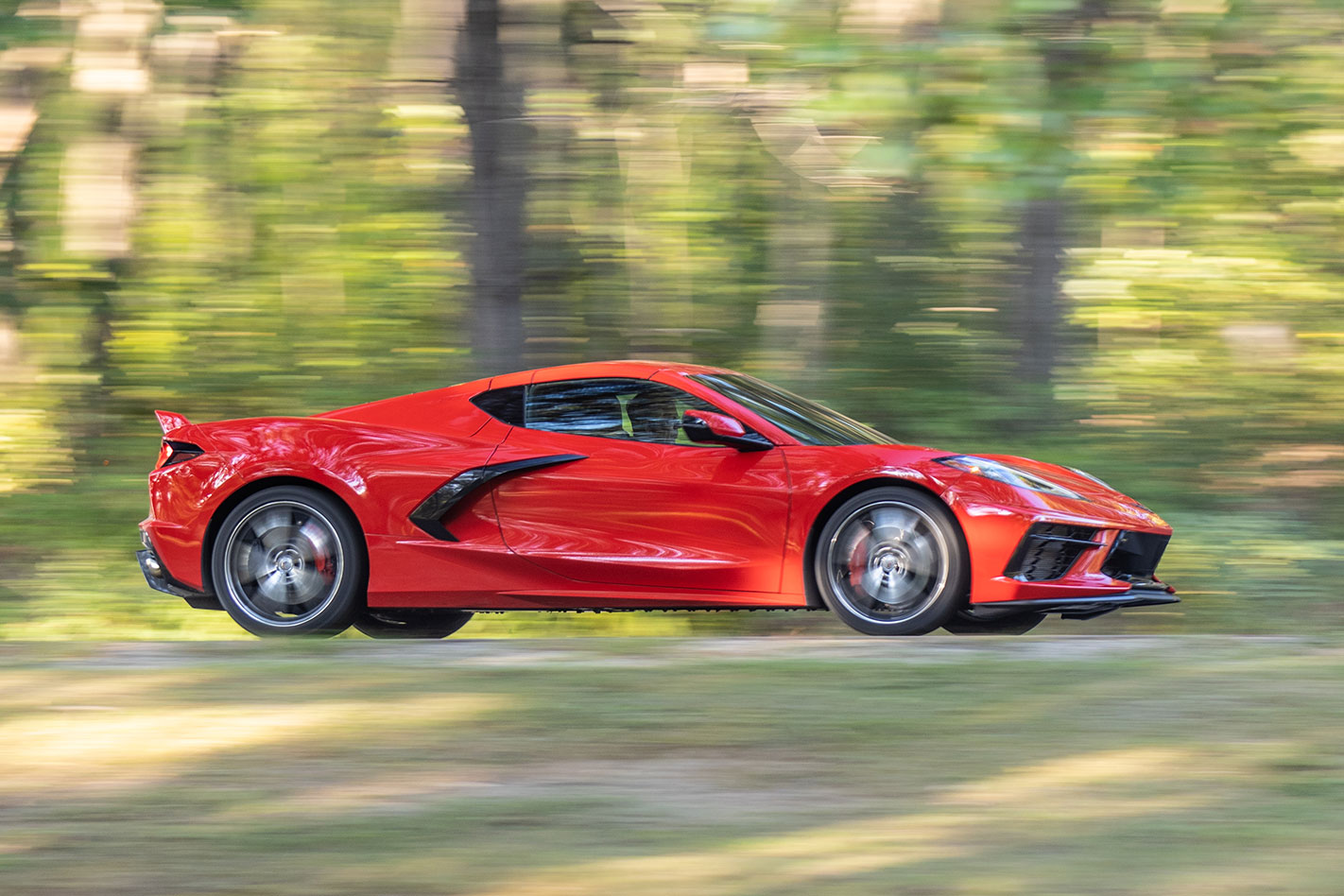
WHAT IS THE CHEVROLET CORVETTE?
The C8 Chevrolet Corvette is the eighth generation of this fabled marque since Chevrolet started turning them out in 1953, and the first mid-engined Corvette. The 6.2-litre LT2 V8 is a new unit but keeps the pushrod and two-valves-per cylinder design of its predecessor, the LT1, as well as the same 6600 rev limit. The atmo bent eight is good for 369kW and 637Nm and a claimed sub-3.0sec 0-60mph time (97km/h).
WHY WE’RE TESTING IT
Because it’s coming to Australia! We’re still pinching ourselves to make sure it’s not a dream. For the first time in 66 years of production, the big Chev is heading our way in an official capacity – which means it’s already right-hand drive. Obviously, the chance to check out the ground-breaking ’Vette in its top spec on the streets of Michigan was too hard to resist.
CHEVROLET CORVETTE C8 REVIEW
Hunger is the best sauce, so those waiting for a mid-engined Corvette have had plenty of time to build a serious appetite. Chevrolet built the first concept in the 1960s and has dropped hints about reversing the order of passengers and powertrain several times since. The previous-generation C7 got closest, having been partially developed with a motor in the middle until GM’s bankruptcy forced a rethink.
We’ll have to wait a while longer. The C8 is about to go on sale in the States but the right-hook Holden version we told you about in our September issue is still a way off. But the basic car is good – really good.
Sitting on an aluminium structure with fibreglass bodywork, the C8 is heavier, 137mm longer and 57mm wider than its predecessor. Indeed, its overall length of 4630mm makes it one of the longest mid-engined cars full stop. Yet while the V8 now sits behind the rear bulkhead and the car’s proportions changed to match, much is familiar.
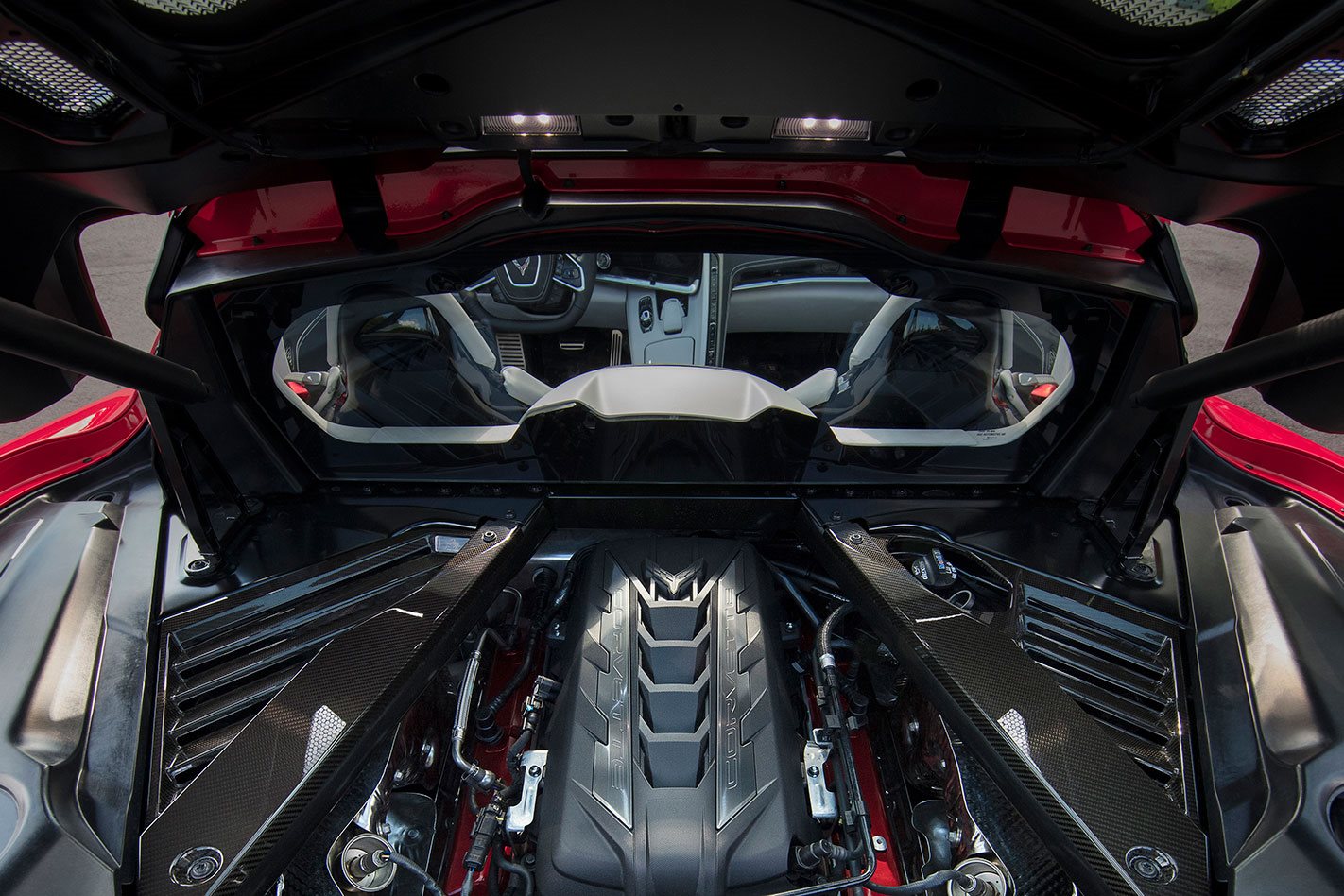
The C8’s shark-nosed styling is clearly related to that of the C7, as is its raised rear end and tail-lamp graphic. The engine is also an old friend, a lightly developed LT2 version of GM’s small block with 6.2-litres of displacement and a claimed 369kW and 637Nm of torque. This works with a standard eight-speed dual-clutch transmission driving the rear wheels. GM confirms there’ll be no manual.
Despite its lack of technical sophistication, the blue-collar engine suits the car perfectly. It’s sonorous, muscular from the basement to the penthouse, and has throttle response to put even the snappiest turbocharged alternatives to shame. It doesn’t rev as high as exotic rivals, but it still sounds great when closing in on its 6600rpm limiter. The higher of the transmission’s eight ratios are tall – cruising economy has long been a Corvette strength – but the lower ones are geared intelligently so the redline never feels too low.
It’s brutally quick, too – somehow faster than its power output and 1530kg dry weight suggest it should be. Chevrolet claims a sub 2.9-second 0-60mph (0-97km/h) time, which feels entirely feasible. Without launch control and on cold tyres, the C8’s in-built performance monitor reported I ran a 3.5-second time by the simple expedient of jumping on the throttle in Drive. Acceleration stays strong well beyond the benchmark figure. The dual-clutch ’box doesn’t add the torque bump to upshifts which most junior supercars do but changes are lightning fast, even in the more relaxed ‘Tour’ mode.
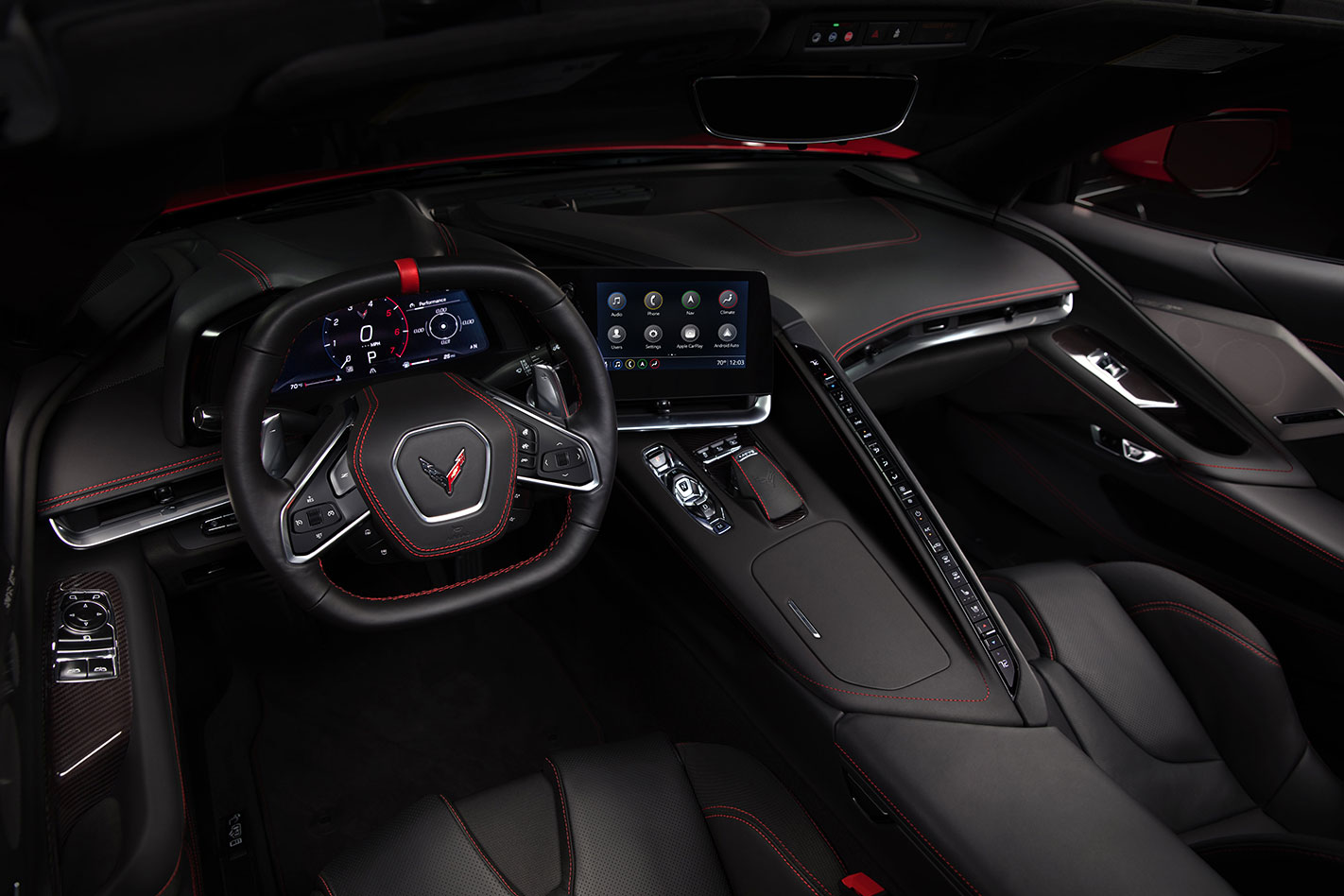
The most obvious dynamic change over the C7 is the chassis’ ability to find traction for the huge urge. The brawniest front-engined ’Vettes always felt edgy and on the brink of big slides under full power, even when travelling in straight lines. The C8 has a lot more adhesion and feels much more stable; even getting close to the limits of lateral grip is hard to do on-road. In tighter turns there is a hint of understeer plus the unsurprising ability to move the handling balance rearwards with a big dose of throttle. But in faster stuff the Corvette just sticks, especially on the mighty Michelin Pilot Sport 4S tyres of the car I drove, part of the optional Z51 performance pack. The regular Corvette comes on less grippy all-season rubber in the States.
The high limits are probably a large part of the reason the steering never really wakes up on-road, with ultra-fast reactions but little sense of loadings on the front axle getting as far as the strangely square-shaped steering wheel. Ride quality is impressive, the optional adaptive dampers keeping body motions under tight control over some of Michigan’s bouncier backroads in both ‘Tour’ and ‘Sport’ modes, even ‘Track’ feeling viable for road use.
Like its predecessors, the C8 has been designed to work as well as play; GM reckons most buyers will use their cars as regular transport and not just weekend toys. Cabin refinement has improved over the C7 and cruising refinement is impressively good, with much less low-frequency noise at constant revs. The engine sits much closer to occupants’ ears but is no louder at everyday speeds.
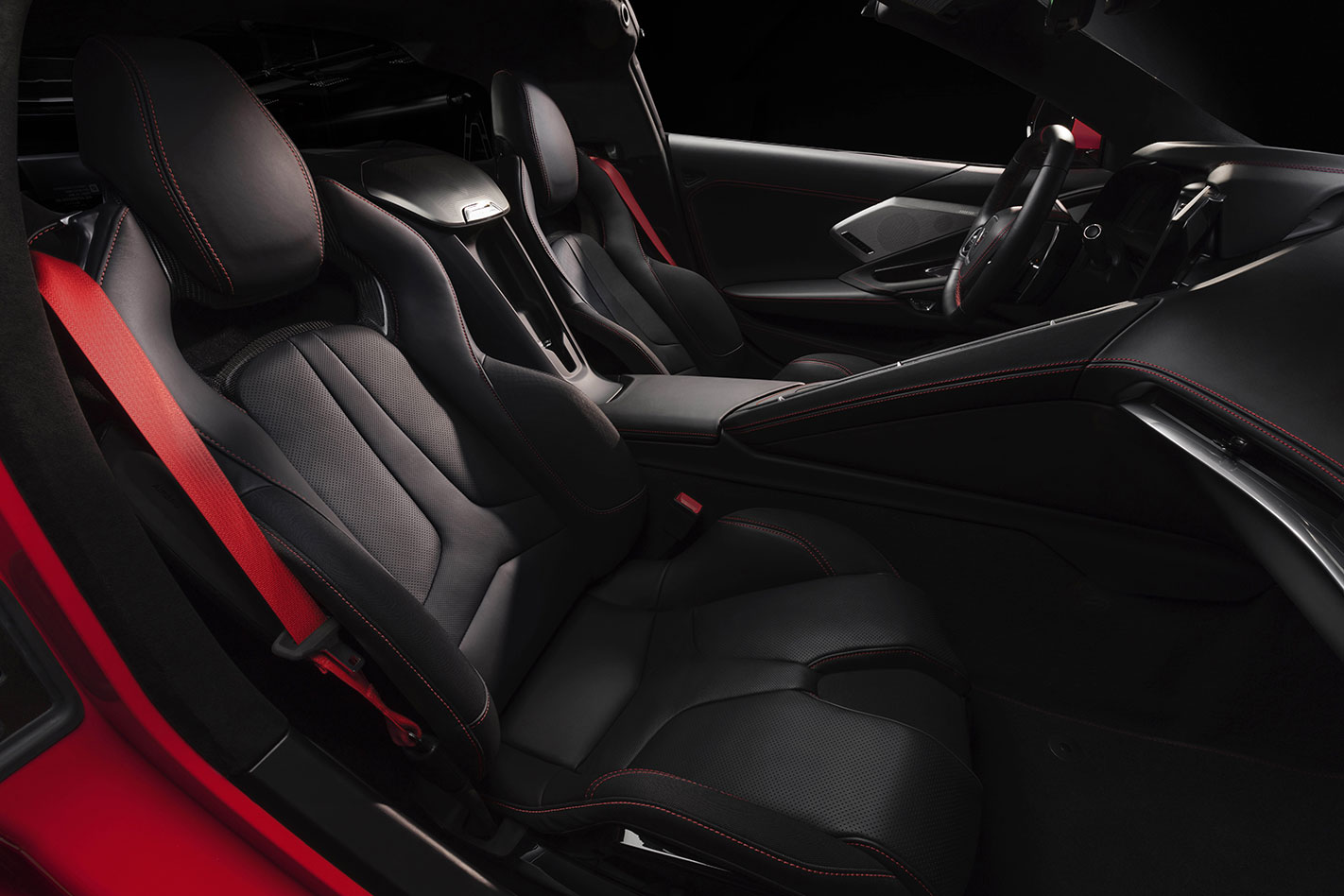
While not exactly spacious, the cabin feels roomier than would be normal in a junior supercar, and trim quality is up several notches. The resin-heavy smell that filled the cabin of previous gens – a manly eau de Corvette – is almost entirely gone. The full-spec 3LT trim car I drove in the US had leather and Alcantara on most touchable surfaces with hard plastics relegated to hard-to-reach places.
There are some ergonomic grumbles. The long row of ventilation buttons on the ridge that separates the two seats are hard to see. The driver’s seat is strangely set higher than the passenger’s, and rearward visibility is poor despite a glass screen above the engine compartment. My test car had an optional camera-based rear-view system, but the display screen was too dim in bright sunshine. The long dash also throws up lots of distracting reflections in the shallow windscreen.
Yet this Corvette is also impressively practical, with 356 litres of luggage space split between a small frunk and a larger compartment behind the engine which can swallow a set of golf clubs. It also still has a targa roof, which can be removed to turn it into a breezy convertible, although storing the lid under the rear deck precludes carrying anything else. (A full convertible will also be offered.)
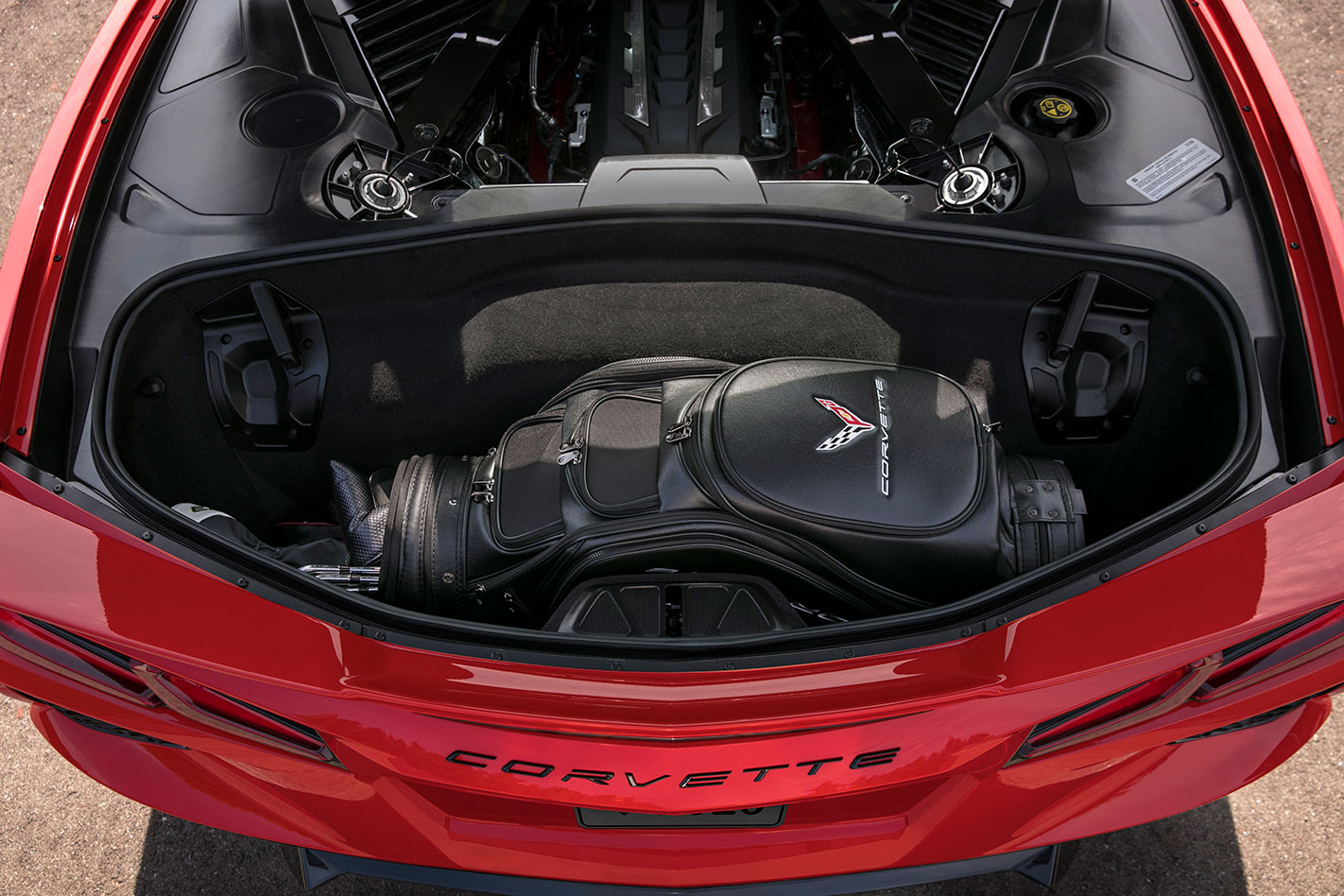
In the US, the Corvette is something close to an outrageous bargain, GM having delivered on its pledge of bringing in the entry-level car at just below US$60,000 – less than a basic four-cylinder Porsche 718 Boxster. Even with the plushest available 3LT trim, the Z51 performance pack (which adds an LSD and bigger brakes to the summer tyres) and the switchable dampers, the Corvette barely breaks US$80,000; less than half what McLaren charges for a 570S in the States. But that’s the greenback. Expect an entry price around A$170,000 when the right-hook C8 hits Oz, possibly before the end of 2020.
The good news is that the C8 is of a standard that suggests it will travel well, and it can be fairly compared with far posher alternatives.
RIVALS:
PRICE AND SPECS
- Model: Chevrolet Corvette
- Engine: 6162cc V8 (90°), ohv, 16v
- Max power: 369kW @ 6450rpm
- Max torque: 637Nm @ 5150rpm
- Transmission: 8-speed dual-clutch
- 0-100km/h: 2.9-sec (estimated)
- Weight: 1530kg (dry)
- Economy: TBC
- Price: $170,000 (estimated)
- On sale: Late 2020 (estimated)
Second Opinion: MOTOR first drive review

Motor focuses exclusively on high-performance cars, offering a heart-stopping, hair-raising blast into the world of prestige and performance culture.
The mighty mid-engined Corvette Stingray is only a year away from Oz, but we couldn’t resist driving it first in California By: Jethro Bovingdon | Photos: James Lipman
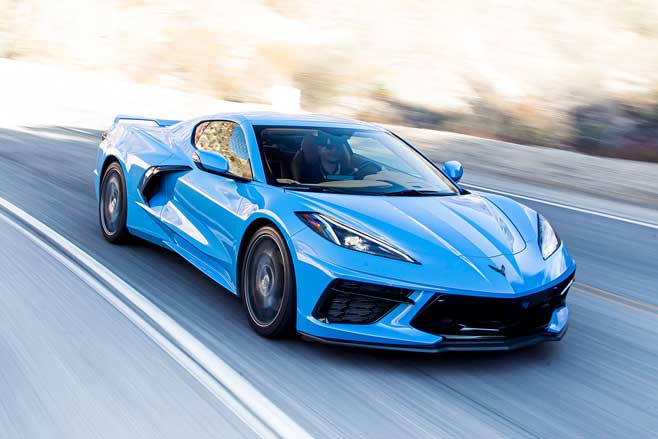
Hype swirls around the new Corvette Stingray like few other cars in recent memory. In the US there have been rumours of a mid-engined ’Vette for decades and people are drooling at the prospect, or outraged that more than 65 years of front-engine heritage has been betrayed. It seems to offer the most outrageous value and yet packs a 6.2-litre V8 with 369kW and 637Nm, and an 8-speed dual-clutch gearbox.
US magazines have already recorded sub-three-second runs to 60mph (97km/h) and 0-100mph (0-160km/h) in the low 7s. This from a car that starts at just $59,995 in its home market, or $10K less than a Cayman S. No wonder there’s so much hype. It looks like Corvette has democratised the supercar.
Let’s not spend too long worrying about what went before and whether placing the engine behind the driver is sacrilege or simply progress. Holden has announced that the Stingray will come to Australia in right-hand-drive form, so what we really need to know is whether this thing is any good.
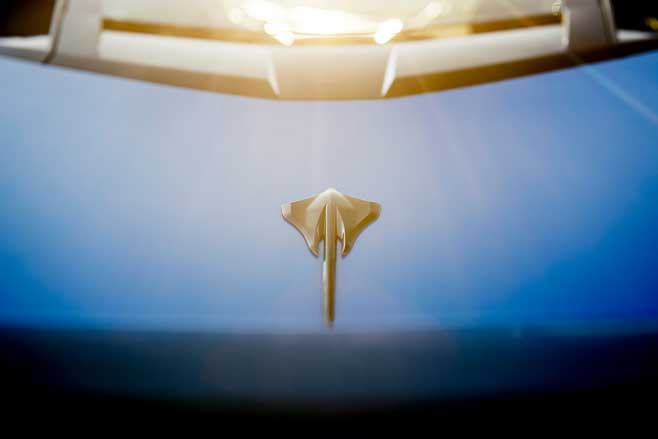
If Chevrolet has finally built a car to take on and beat the rest of the world and it’s available to buy here through your local Holden dealership… well, who cares about talk of legacy and heritage and all that nonsense? Don’t tell anyone I said this, but most of the older Corvettes sucked anyway.
Sadly, the stylists weren’t as keen as the engineers to cut the baggage loose. The inescapable truth is that the C8’s styling is rather conservative, slightly clumsy and very definitely weighed-down with all that history.
There’s drama in the shape, but park it beside something from McLaren or Ferrari and it looks heavy-handed and rather dated already. Even in the context of a 718 Cayman, the Stingray looks like it’s trying way too hard. A shame but maybe not a deal-breaker, as there’s so much good stuff going on beneath the fussy lines.
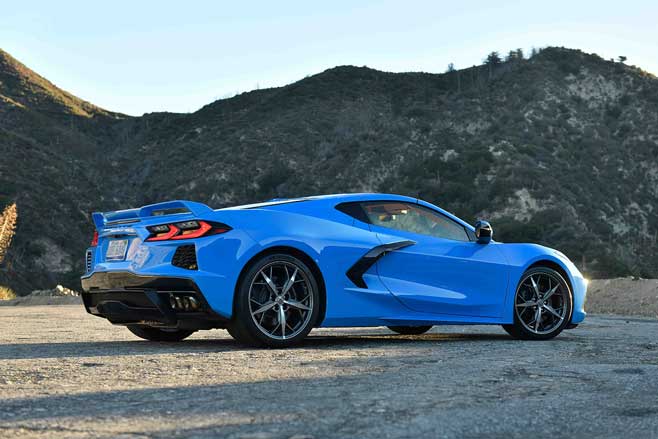
The C8 is built around a central aluminium spine, essentially a three-sided box-section that’s closed for added stiffness with a carbonfibre panel. Aluminium subframes bonded and screwed in place carry the double-wishbone suspension all round and cradle the powertrain.
The Stingray weighs 1530kg dry. I wish it were a little lighter, but the chassis is a hell of a piece of engineering for a car that will be built in great volumes – up to 40,000 a year – at a pretty reasonable price.
Encouragingly, the thing you notice when you walk around the C8 for the first time is just how low they’ve managed to locate the engine in the chassis. Dimensionally, it’s full-scale supercar – longer than a Ferrari F8 Tributo and with a significantly increased wheelbase, a shade narrower and 28mm taller.
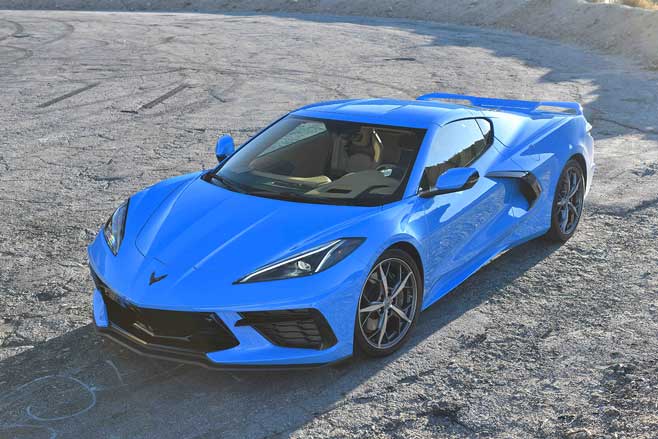
Now, let’s talk options. Not leather and infotainment packages – of which there are many – but performance options to unleash the Corvette’s sharpest, most focused character traits.
The big one is the Z51 Performance Package, which comprises uprated suspension with manually adjustable threaded spring seats, bigger brake discs with four-piston monobloc calipers all round, enhanced cooling, shorter gearing, electronic limited-slip diff, performance exhaust and a fixed wing. It’s a USD$5K option and our Rapid Blue Z51 test car has the additional benefits of Magnetic Selective Ride Control (USD$1895).
It’s also fully loaded with the 3LT interior (USD$11,000), has Competition Sports Bucket Seats and a few other goodies to take the total to USD$83,825. That’s a chunk more than the headline-grabbing base price, but still spectacular value.
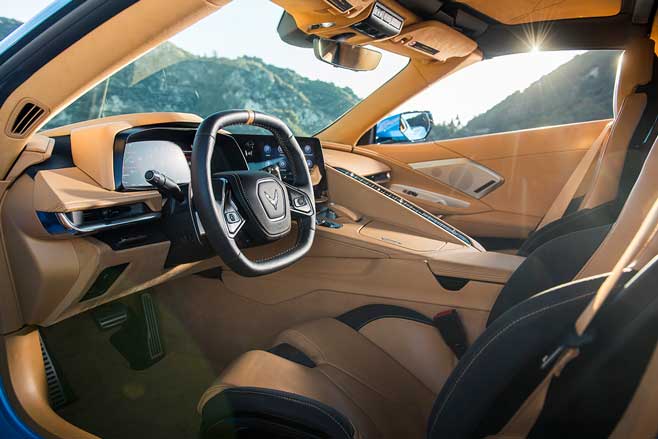
Swing open the door and drop into the tight-fitting seats and you’ll remain convinced that’s the case. The square-topped steering wheel looks odd but gives a fantastic view of the instrument binnacle, and the intensely driver-focused layout shows the C8 team really cared about the person in the hot seat.
The V8 starts with a nice, big boom but settles back to an almost restrained idle, and even when I hit the Z button on the steering wheel that has been pre-loaded with Sport or Track settings for most parameters, the noise is pretty polite.
The C8 has Weather, Tour, Sport, My Mode and Track modes as well as Z mode, which you can shortcut to via the aforementioned button. The small-block’s smooth, slightly distant noise suggests powerful GT car rather than hair-on-fire supercar.

First impressions continue along the same theme. The ride is extremely good – quieter than even a McLaren with its trick hydraulically linked dampers and lack of anti-roll bars – with a lovely sensation of well-oiled smoothness mixed with effortless precision. Sport is the sweet spot, as Track goes too far for even quite smooth roads. It’s nice to feel such defined steps between the modes, though.
The electric power steering also has various weighting options but in essence is light, very clean in feel and reaffirms a sense of inherent agility if you avoid the needlessly stiff and sticky-feeling Track mode.
Quite simply, there’s a polish and fluidity here that I haven’t experienced in previous Corvettes and the dynamic package immediately feels poised, alert and yet well within itself. And I love the driving position; you sit so far forward and have an amazing view ahead, very much like an original Honda NSX.

The engine is naturally endowed with a fabulous breadth of performance, and such is the traction available Chevy has given the C8 very short gearing in the first two ratios. It’s a nice introduction to the V8’s insistent and linear power, then once you’re rolling along in third or higher you get to feel its any-rev muscle.
The LT2 V8 doesn’t have the sweet, cultured tone of, say, the Porsche flat-six in a Cayman GT4, but there’s something intoxicating about the big-cube feel and sound. If only the 8-speed dual-clutch had a tighter, punchier shift. I’m sure the computer says it hits as hard and fast as a PDK but it doesn’t feel it. In fact, you could almost be forgiven for thinking it was a really good torque-converter auto rather than a dual-clutch unit. It needs more edge.
Pretty soon you start to wonder if the whole car doesn’t need a bit more edge. The Stingray flows with a lovely sense of calm, the steering light and precise if a little lacking in texture and feedback, the front-end quick to respond but never manic or jumpy, and there’s so much traction available that once the nose has bitten you can load the rear axle with torque and know it will deploy every last bit.
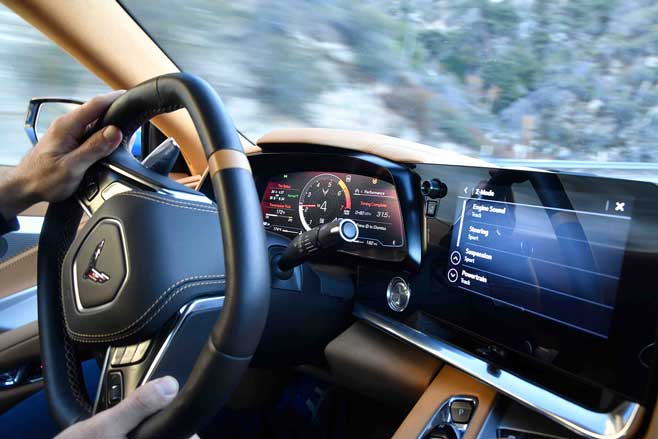
There’s a real efficiency about the way the C8 tackles a road, and it always feels within itself even when you’re starting to really push. Yes, there’s a trace of understeer at the limit, and just occasionally over bumps on corner entry you suddenly sense a lot of weight behind you, but this is a car with real composure even under duress. In fact it positively invites you to up your own commitment to experience everything it has to offer.
What you don’t get is an expressive driving experience or one rich in feedback and adjustability. Try to impose yourself on the C8 by braking hard into turns or really gassing the V8 early in corners and it remains relatively benign and seems reluctant to really indulge the driver. It’s extremely impressive but maybe a shade too buttoned-up.
Having complained about the snappy on-limit behaviour of the C7, it seems unfair to call the C8 too well-mannered, but I can’t help feeling that making it a touch more aggressive on turn-in and a little stiffer at the rear to bring the tail into play would make for a more intense and exciting experience.
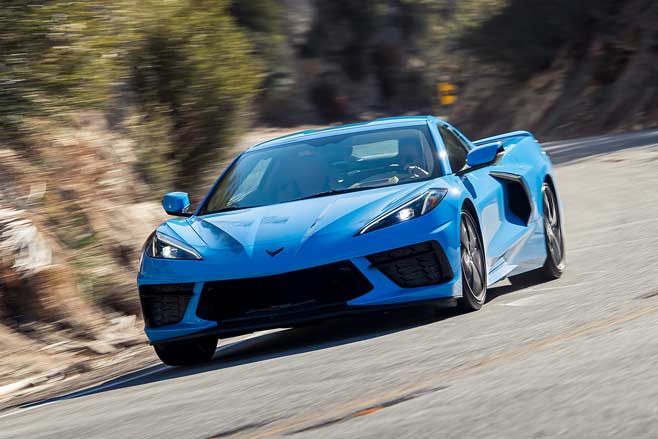
I understand this is the entry point for the new mid-engined Corvette and there are faster, more focused iterations to come, but the beauty of rivals from the likes of Porsche is that they play the everyday card perfectly and then offer infinite entertainment and adjustability. A little more of that split personality would be very welcome.
Even so the new Corvette is a deeply impressive car. Its talent runs deep and doesn’t feel artificially magicked out of extreme tyres or crazy spring rates. The feeling of agility and composure is inherent in the chassis, suspension and engine location. Even better is that the car celebrates its mid-engined configuration.
The styling had led me to believe the Corvette might feel like its radical new architecture was done begrudgingly rather than embraced for all the benefits it can bring. Yet when it’s flowing down a twisting road and you feel right at the point of an arrow, masses so well controlled and with all that lovely traction to lean on, there’s no doubt the engineers wanted to show that abandoning the old layout wasn’t a necessary evil but instead opened up a whole new world of possibilities.
This standard Corvette Stingray, even in Z51 configuration, isn’t the natural conclusion of that bold step into the future. But it’s a hell of a place to start.
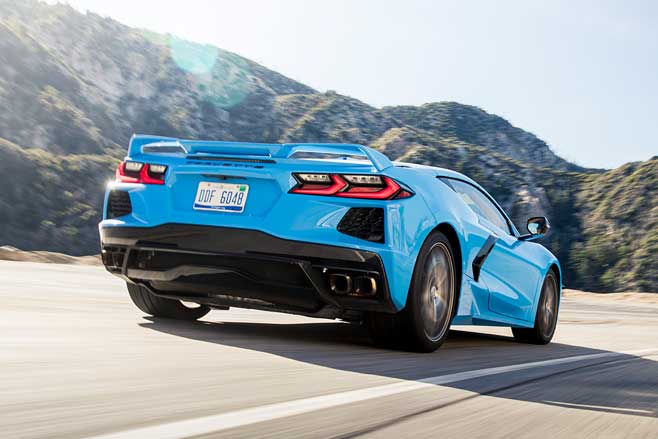
FAST FACTS 2020 Chevrolet Corvette Stingray Z51 BODY: 2-door, 2-seat coupe DRIVE: rear-wheel ENGINE: 6162cc V8, OHV, 16v BORE/STROKE: 103.2 x 92.0mm COMPRESSION: 11.5:1 POWER: 369kW @ 6450rpm TORQUE: 637Nm @ 5150rpm WEIGHT: 1530kg (dry) POWER-TO- WEIGHT: 241kW/tonne (dry) TRANSMISSION: 8-speed dual-clutch SUSPENSION: double wishbones, adaptive dampers, coils (f); double wishbones, adaptive dampers, coils, anti-roll bar (r) L/W/h: 4630/1934/1234mm WHEELBASE: 2722mm TRACKS: 1648/1586mm (f/r) STEERING: electrically assisted rack-and-pinion BRAKES: 345mm discs, 4-piston calipers (f); 350mm discs, 4-piston calipers (r) WHEELS: 19.0 x 8.5-inch (f); 20.0 x 11.0-inch (r) TYRES: Michelin Pilot Super 4S; 245/35 ZR19 (f), 305/30 ZR20 (r) PRICE: AUD$240,000 (as-tested, estimate); AUD$175,000 (base model, estimate)
PROS: Lovely flow; driving position; ride; traction; value CONS: Could be sharper; overweight; fussy styling; gearbox RATING: 4.5 out of 5 stars
Things we like
- Huge performance
- Impressive practicality
- Set to come here!
Not so much
- Ergonomic niggles
- Low-feel steering
- Bargain US pricing won't translate





